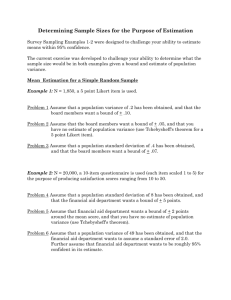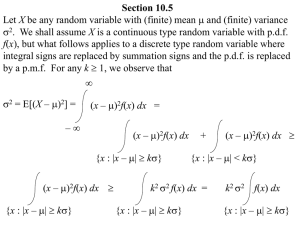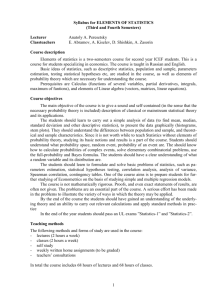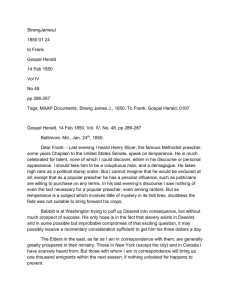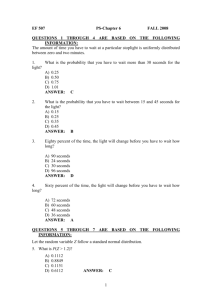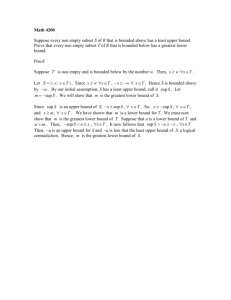Determining Sample Sizes for the Purpose of
advertisement
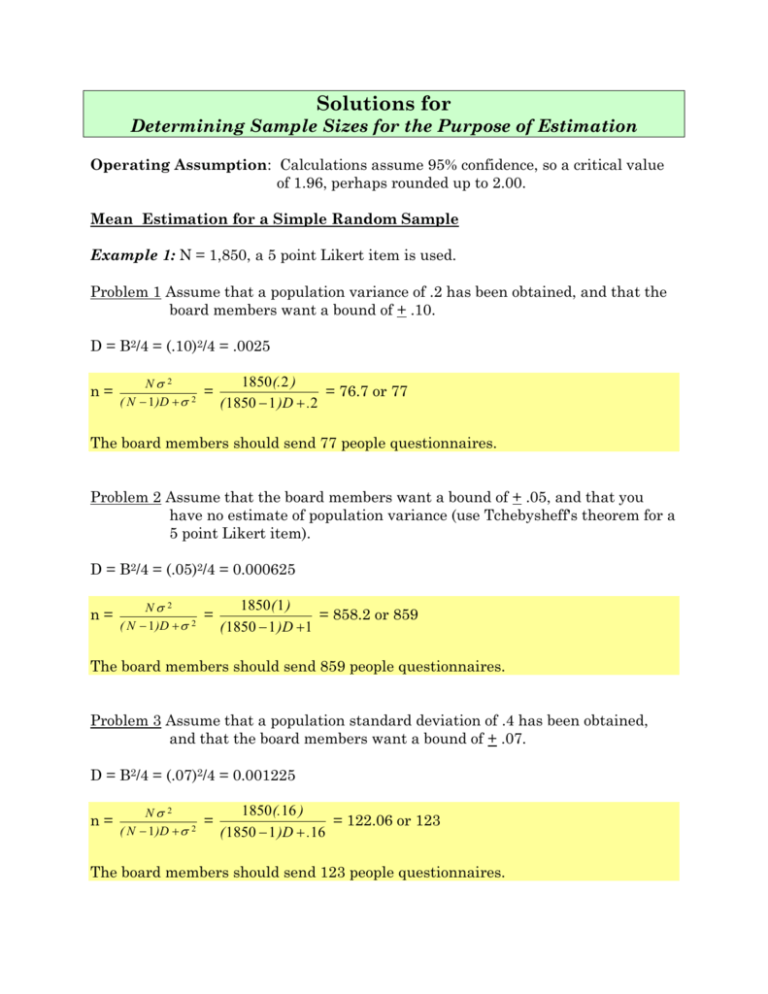
Solutions for Determining Sample Sizes for the Purpose of Estimation Operating Assumption: Calculations assume 95% confidence, so a critical value of 1.96, perhaps rounded up to 2.00. Mean Estimation for a Simple Random Sample Example 1: N = 1,850, a 5 point Likert item is used. Problem 1 Assume that a population variance of .2 has been obtained, and that the board members want a bound of + .10. D = B2/4 = (.10)2/4 = .0025 n= N 2 ( N 1 )D 2 = 1850 (.2 ) = 76.7 or 77 ( 1850 1 )D .2 The board members should send 77 people questionnaires. Problem 2 Assume that the board members want a bound of + .05, and that you have no estimate of population variance (use Tchebysheff's theorem for a 5 point Likert item). D = B2/4 = (.05)2/4 = 0.000625 n= N 2 ( N 1 )D 2 = 1850 ( 1 ) = 858.2 or 859 ( 1850 1 )D 1 The board members should send 859 people questionnaires. Problem 3 Assume that a population standard deviation of .4 has been obtained, and that the board members want a bound of + .07. D = B2/4 = (.07)2/4 = 0.001225 n= N 2 ( N 1 )D 2 = 1850 (.16 ) = 122.06 or 123 ( 1850 1 )D .16 The board members should send 123 people questionnaires. Example 2: N = 20,000, a 10-item questionnaire is used (each item scaled 1 to 5) for the purpose of producing satisfaction scores ranging from 10 to 50. Problem 4 Assume that a population standard deviation of 8 has been obtained, and that the financial aid department wants a bound of + 5 points. D = B2/4 = (5)2/4 = 6.25 n= N 2 ( N 1 )D 2 = 20000( 64 ) = 10.23 or 11 ( 20000 1 )D 64 11 students should receive a questionnaire from the financial aid department Problem 5 Assume that financial aid department wants a bound of + 2 points around the mean score, and that you have no estimate of population variance (use Tchebysheff's theorem). D = B2/4 = (2)2/4 = 1 n= N 2 ( N 1 )D 2 = 20000 ( 100 ) = 99.51 or 100 ( 20000 1 )D 100 100 students should receive a questionnaire from the financial aid department Problem 6 Assume that a population variance of 49 has been obtained, and that the financial aid department wants to assume a standard error of 2.0. Further assume that financial aid department wants to be roughly 95% confident in its estimate. D = B2/4 = (4)2/4 = 4 n= N 2 ( N 1 )D 2 = 20000( 49 ) = 12.24 or 13 ( 20000 1 )D 49 13 students should receive a questionnaire from the financial aid department Proportion Estimation for a Simple Random Sample Example 3: How many students should have been interviewed? (Assume N = 2000 and a desired bound of .02). Use the maximum variance possible for a proportion. D = B2/4 = (.02)2/4 = 0.0001, 2 = p(1-p) = p(1-p) = .5(1-.5) =.25 n= N 2 ( N 1 )D 2 = 2000(.25 ) = 1111.358 or 1112 ( 2000 1 )D .25 1112 students should have been interviewed. Mean Estimation for a Stratified Random Sample Example 4: The sixth grade contains 55 students in track I, 80 students in track II, and 65 students in track III. A stratified random sample of students, proportionately allocated, is desired. Assuming a bound of .05 and prior evidence that the scores have a variance of 10, determine what sample size is needed. 55 3.16 * N 1 1 = 0.275 w 1= = 3 55( 3.16 ) 80( 3.16 ) 65( 3.16 ) Ni i i 1 80 3.16 * N 2 2 = 0.400 w 2= = 3 55( 3.16 ) 80( 3.16 ) 65( 3.16 ) Ni i i 1 65 3.16 * N 3 3 = 0.325 w 3= = 3 55( 3.16 ) 80( 3.16 ) 65( 3.16 ) Ni i i 1 * Please Note: The number 3.16 is the square root of 10. I did not actually round this number when performing this calculation. D = B2/4 = .052/4 = 0.000625 55 2 (3.16) 2 80 2 (3.16) 2 65 2 (3.16) 2 3 N i2 i2 55 ( 3.16) 80 ( 3.16) 65 ( 3.16) Wi i 1 632 632 632 n= = = 197.53 or 198 2 3 2 2 200 0.000625 55 (3.16) 80 (3.16) 65 (3.16) 2 2 2 N D N i i i 1 n 1 = n (w 1) = 197.53(0.275) = 54.32075 or 55 students in Track I. n 2 = n (w 2) = 197.53(0.400) = 79.012 or 80 students in Track II. n 3 = n (w 3) = 197.53(0.325) = 64.19725 or 65 students in Track III.
